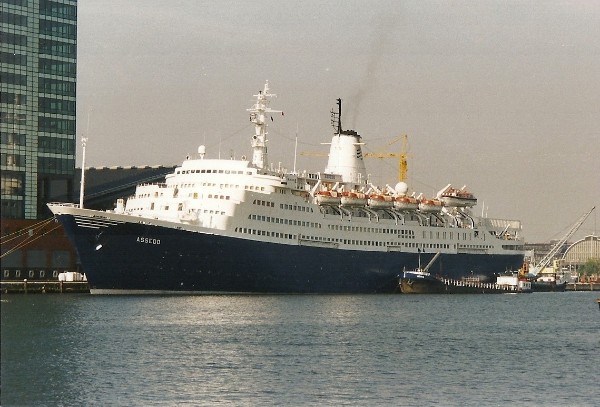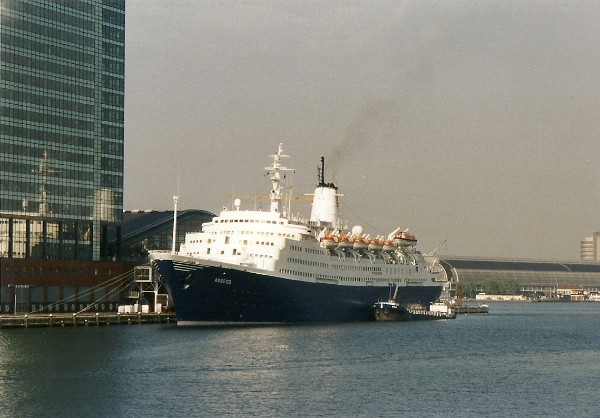Assedo

Above, Assedo is shown at the cruiseterminal in Amsterdam at the 15th of august of 2001. At that time, the former Shota Rustaveli was sailing for the Russian company Metropolis-Tur.
Assedo isn't exactly a word, it is just a play with the name of her homeport, Odessa. Spelled backwards, you have of course her name. This ship was built as a unit of a class of five equal ships for the Sovjet Black Sea Shipping Company. This was one of the three main Sovjet state-owned companies, the other ones were the Far Eastern Shipping Company that was based in Wladiwostok and the Baltic Shipping Company, based in Murmansk. The first ship of the class, that was originally built for cruising as well as the transatlantic services between Leningrad (now St.-Petersburg) and Montreal, was built in 1963 under the name of Ivan Franco. She was followed in 1964 by Aleksandr Pushkin, that is nowadays the last ship of the class that survives under the name of Marco Polo.
Shota Rustaveli was launched from the Mathias-Thesen werft in Wismar, East Germany at the 29th of december 1966. The ship measured 19.567 tons and had a lenght of 175,77 meters. She was 23,55 meters wide and her draft was 8,09 meters. Although the class of ships were originally meant for transatlantic voyages, the Shota Rustaveli never sailed as such. She was purely used as a cruiseliner. Her earlier sisters did sail some transatlantic voyages though. Shota Rustaveli had accomodations for 750 cruisepassengers and around 350 crewmembers. She sailed under the Sovjet-flag and her homeport was Odessa. At that time, the Sovjet cruisefleet was the largest in the world, BLASCO being one of the main reasons. Strangely, most of the cruiseliners were dedicated to the western market, although it was the height of the Cold War. But these ships could be used to earn hard-value western money and this was more then welcome. For young Sovjets, sailing on one of those ships also gave them the opportunity to see beyond the normally closed borders and into the world of the big enemy, The West. The ship was finally delivered to Black Sea Shipping Company at the 30th of june 1968, after which date she began her cruiseservice for the company, as well as charters she undertook for several western cruiselines.

In 1975, the ship was rebuilt to a tonnage of 20.146 and she was now able to sail with 650 passengers, so her original number of passengers was decreased. In this rebuilding, some cabins have been enlarged so more space could be offered and the ship was able to compete more with the more modern liners that were built. She sailed her services for BLASCO without interruptions untill 1991. In this year, the fall of communism ended the Sovjet state and the country was falling apart when most former Sovjet republics gained their independence. Because Odessa was now in the state of Ukraine, Shota Rustaveli was brought under Unkrainian flag. This was of course not a problem, but what was a problem was that the companies, that were normally state-controlled, now had to commercialize to keep up with the companies from the west. This new way of thinking was very hard for the former Sovjet companies and close to all of them dissappeared throughout the 1990's. Even the big company BLASCO, that was the largest in the Sovjet Union and that had always been looking to the west before, did not survive. In 1995, a division called BLASCO UK, based in the United Kingdom, took over the management of several ships including Shota Rustaveli. Two years later, the ship was resold to a company based in Odessa, Ocean Agencies. For them, she was rebuilt and her passengercapacity decreased once more, now she had room for 608 passengers in total.
In 2001, the ship was sold to Kaalbye Shipping International from Kingstown and she was renamed Assedo. From june 2001 onwards, she was chartered to the Russian company Metropolis Tur. But at the 11th of june, when her first cruise was about to start from Odessa, the weather was considered too bad to sail, so she stayed put and her passengers, that had already boarded the ship, were brought over to hotels in Odessa. This situation lasted for a week, so you can imagine those passengers were not really happy about this. When she sailed for Metropolis Tur, it brought her to western Europe and the Mediterranean, but this only lasted for two years. On the 22nd of october 2003, the ship was sold to be scrapped in Alang, India, where she arrived at the 28th of november.

